In the world of floristry beauty is an everyday thing, but as with most things in life, beauty is often in the eye of the beholder.
Flowers Across Melbourne scoured the globe to find the weirdest flowers in the world so take a seat, grab a drink and get ready to check out 40 flowers that are stranger than fiction.
#1. Monkey Face Orchid (Dracula simia)
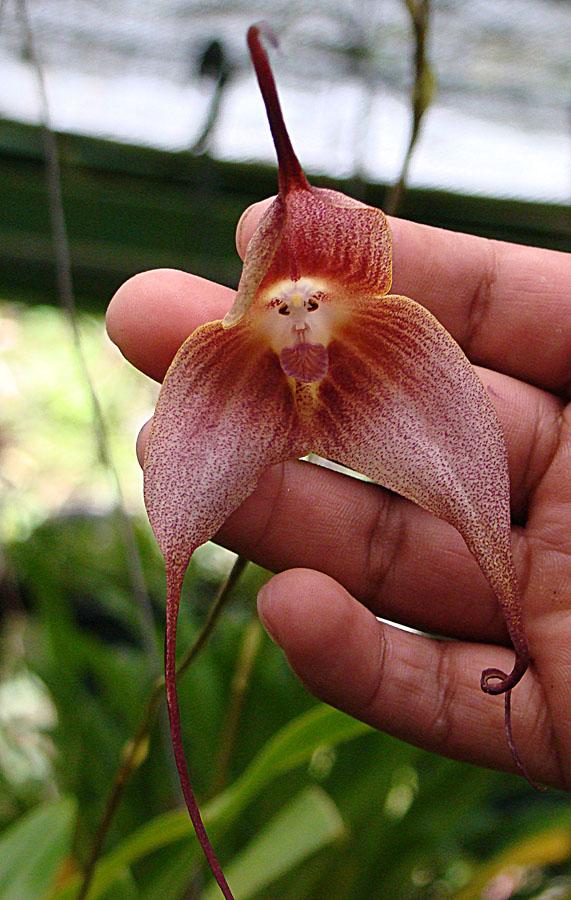
Photo courtesy of Dick Culbert (cc)
Let’s face it (pun intended), this little guy didn’t take a whole lot of imagination to name; “Dracula” because of it’s two long, fang-like petals and “simia” for its resemblance to primates. The two dark little eyes, fuzzy dotted eyebrows, and furry little nose and beard area bear striking simian similarities that become even more apparent when viewed from a distance.
The Monkey Face Orchid is rare oddity so don’t get upset if you’ve never seen one before. It is only found in the cloud forests of Peru and southeastern Ecuador at altitudes of more than 3,000 feet. It can bloom all year round, and its flowers smell like ripe oranges, making it a prized addition to any orchid connoisseurs garden.
#2. Bat plant (Tacca integrifolia)
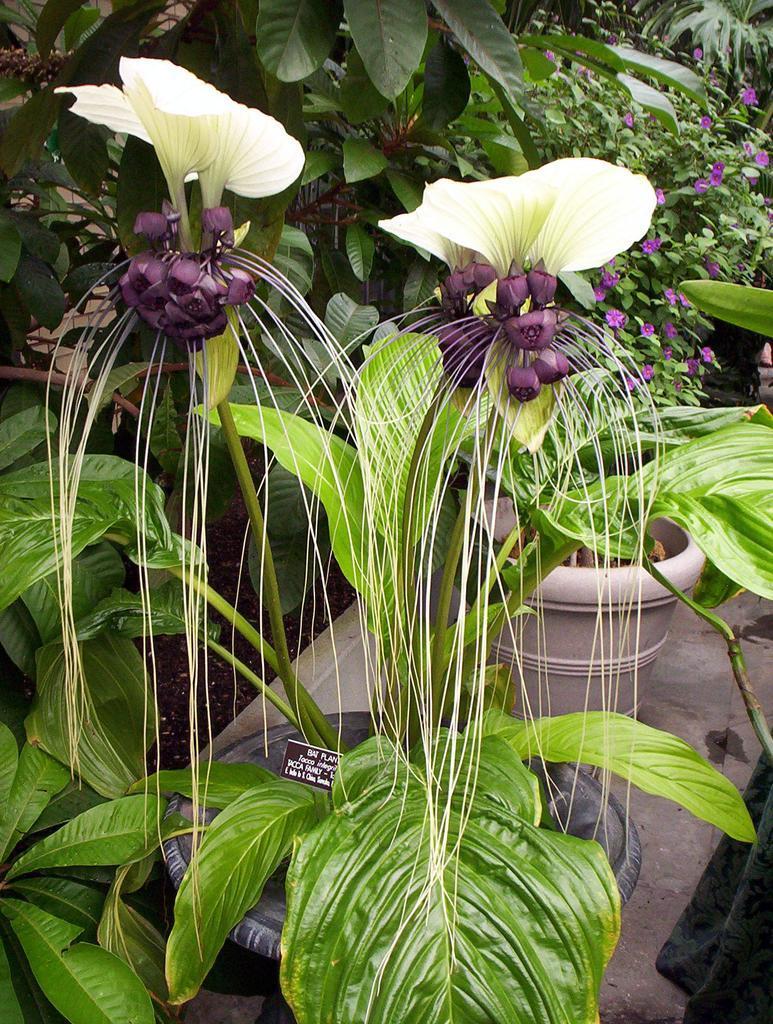
Photo courtesy of Vicki Ashton (cc)
The White Bat Plant is one of the world’s largest and most unusual flowers. It’s strange little black flowers come in clusters of twenty to forty and resemble bats’ faces while the white bracts above resemble bats’ ears. The Bat Plant can grow to anywhere between 60 and 90 centimetres tall and comes in both a black version and a white version. The whiskers of the flower will also grow quite long, sometimes reaching all the way to the ground. An interesting fact about this weird wonder is that despite its resemblance to the lily it is actually a member of the yam family!
#3. Moth Orchid (Phalaenopsis amabilis)
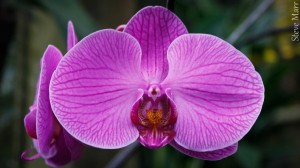
Photo courtesy of Steve Marr (cc)
With more than 25,000 different kinds of orchids on the planet, it’s no wonder that more than a couple of them made our weird list. The Moth Orchid is the most common type of orchid and bears the name because of its supposed resemblance to a moth in flight. Native to Southeast Asia, the Philippines, and northern Australia, the Moth Orchid isn’t exactly hard to find, and it comes in nearly every colour of the rainbow. So what exactly sets it apart from its 24,999+ orchid siblings? The Moth Orchid’s uncanny ability to have multiple blooming periods— when grown in optimal conditions of course!
#4. Corpse Flower (Rafflesia keithii)

Photo courtesy of Mike Prince (cc)
Next on our list comes a rather morbid yet beautiful flower— Rafflesia keithii, or, the Corpse Flower. There is a bit of a debate over whether or not the true corpse flower is the Rafflesia keithii or the Titan arum. If you’ve seen the movie Dennis the Menace than you may remember the flower that Mr. Wilson waited nearly 40 years to see bloom—that’s the Titan arum. The Corpse Flower of which we speak now is much rarer and can only be found in the rainforests of Indonesia. The Corpse Flower is a parasitic organism that has no visible leaves, roots or stems, causing some to argue that the Corpse Flower isn’t a flower at all—rather a fungus. In addition to its vampiric traits, the Corpse Flower is the world’s largest individual flower. Still wondering why it’s nicknamed the Corpse Flower? Let’s just say don’t breathe in its scent too deeply.
#5. Naked Man Orchid (Orchis italica)
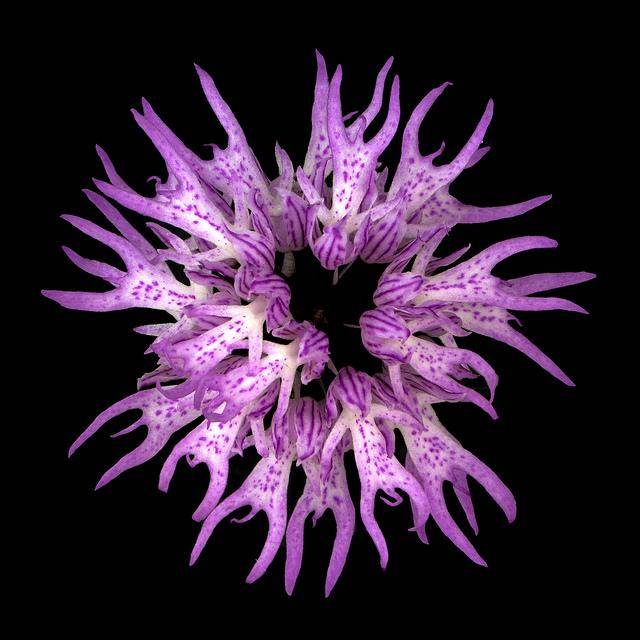
Photo courtesy of Mark Freeth (cc)
Is it an alien? Is it a sea anemone? Nope, it’s the Naked Man Orchid! This little guy (or guys) also known as the Hanging Man Orchid, are native to the Mediterranean regions and resemble tiny little hanging naked men, from their dotted eyes and smiles right down to their you-know-whats. Naked Man Orchids come in all sizes and usually, range in colour from light purplish white to deep purply-pink. The Naked Man Orchid is classified as having a threatened status, perhaps because of its popularity as an antidiarrheal, antiflatulent and aphrodisiac. Another crazy fact about these fun flowers: they’re used in making the drink Salep, also called Turkish Delight.
#6. Hooker’s Lips (Psychotria elata)

Image source unknown
Hooker Lips, Hot Lips, Flower Lips— call them what you will— there’s no guessing how this plant got its name. The bright red bits that resemble a hooker’s bright red lips are bracts, not petals. The leaf-like bracts are only in their kissable state for a few days before opening to reveal the little yellow and white flowers within. The Hooker’s Lips Plant is native to the tropical regions of Colombia, Costa Rica, and Panama, but due to its popularity with collectors and the deforestation of its natural habitat it’s landed on the endangered list. Hope we don’t have to kiss this little beauty goodbye anytime soon!
#7. Dancing Girls (Impatiens bequaertii)
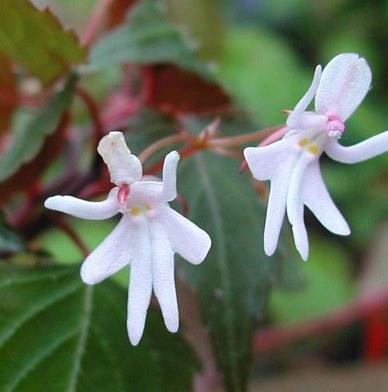
Image source unknown
These little beauties are one of the rarest flowers around and prove quite hard to find even for the most determined plant collector. Nicknamed for their resemblance to dancing ladies in dresses, these tiny flowers are native to East Africa and come in white and light pink. The plant itself is quite petite, growing to just about one foot across and bearing blooms that max out at ½” long. Dancing Girls trail and climb, so they make lovely additions to hanging planters where you can enjoy their fabulous flowers at eye-level. Dancing Girls will root wherever they touch the soil, and they make excellent indoor plants if you can find one.
#8. Subterranean Plant (Hydnora africana)
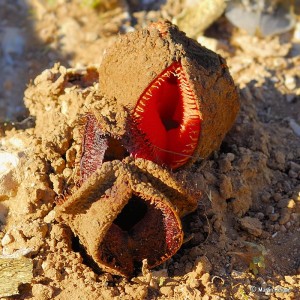
Photo courtesy of Martin Heigan (cc)
Nope, you’re not seeing things, that’s a plant, not a monster! This South African subterranean plant is truly one of the most bizarre plants on Earth. Despite its crazy look, it’s actually semi-common in the arid regions of South Africa. The Hydnora africana also called Jackal Food by the locals, has no visible leaves, roots or chlorophyll. It is strictly a parasitic, underground plant whose flowers take nearly one year to emerge from the ground. Despite its monstrous look and disgusting scent, the Hydnora africana produces tasty berries that are just delicious when baked over an open fire. The fruit also has astringent properties and has been used for preserving fishnets, for tanning, and infused in face wash as an acne treatment.
#9. Bee Orchid (Ophrys apifera)

Photo courtesy of Björn Sothmann (cc)
This happy little guy gets its name from its uncanny resemblance to a smiling bumblebee; that is if bumblebees could smile. Its name comes from the Greek word “Ophrys” meaning eyebrow, perhaps referring to the fuzzy bits around the edge of the flower. The Bee Orchid is widespread across Europe the Middle East and even North Africa. However, it’s becoming more and more scarce because the propagation process is so complicated. You see, the Bee Orchid requires a symbiotic relationship with a particular type of fungus to successfully grow, making transplanting tough. This orchid is more clever than it appears; the flowers are almost exclusively self-pollinating in the northern ranges, but the colouring and shape of the flower mimic the look and smell of a female bee which entices male bees towards it to mate, thus expediting the pollination process!
#10. Swaddled Babies (Anguloa uniflora)
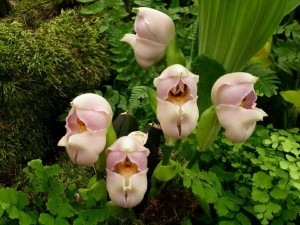
Photo courtesy of Tim Waters (cc)
Too cute! These tulip orchids, nicknamed Swaddled Babies, were discovered in the Colombian Andes between 1777-1788 during a ten-year expedition but weren’t named and officially classified until 1798. During certain times of the plant’s blooming stage, the flowers’ unique shapes resemble that of a baby all wrapped up in white swaddling. Their tempting scent attracts insects to the hinged lip of the petal where the unsuspecting creatures are shoved into the column, where a pack of pollen then attaches itself to their abdomens, increasing pollination.
#11. Parrot Flower (Impatiens psittacina)

Image source unknown
If you’ve never seen a Parrot Flower before you’re not alone. The Parrot Flower, a Thailand native, is classified as endangered and therefore not allowed to leave the country. The neat thing about the flower of this rare species of balsam is that when you look at its side profile, it looks just like a parrot or cockatoo in flight! Funny thing is, when images of this flower began to circulate across the Internet they were dismissed as being “digitally manipulated” or Photoshopped because very few people had actually seen one since they are so extremely rare in the wild, and it’s illegal to remove them
#12. Snap Dragon Seed Pod (Antirrhinum majus)
If you’ve ever had any doubt as to whether or not a flower is a living creature, here’s the proof! Many gardeners and horticulturists are fond of Snapdragons for their bright colors and fragrance—not to mention if you squeeze the sides of a Snapdragon flower it looks like a dragon’s mouth opening and closing— but not so many gardeners and horticulturists know about the dragon skulls that are left once the Snapdragon has gone to seed! Interestingly enough, in ancient times, people believed Snapdragons held mystical powers, and that and that growing them in one’s garden would protect one’s home from curses and evil. These tiny, perfect little skulls are quite a reminder of the circle of life, wouldn’t you say?
#13. Flying Duck Orchid (Caleana major)
This fowl orchid is just too cute! Native to Australia, this orchid’s unique shape helps increase its pollination. Sawflies are attracted to its scent and land on the “bill”, where their weight forces them down and inside the flower, temporarily curling the “bill” down and in. From there, the only way out is through a pollen-laden section of the flower where the sawfly finds and then emerges from. You’d think such a unique looking flower would be easy to find. However, it’s reddish brownish colouring makes it blend right into the Australian bush. Want to add the Flying Duck Orchid to your home greenhouse? Sorry! This flower only grows in the wild, in Australia, and has never been propagated. Why you ask? Because in order to grow, it depends symbiotically on a particular type of vegetative fungus that only grows in Australia. It’s an excellent excuse to go on a vacation, though!
#14. Tiger face in Moon Orchid (Phalaenopsis amabilis)

Photo courtesy of Max Fulcher (cc)
The moon orchid is one of Indonesia’s three national flowers the flower of charm, the other two are Jasminum sambac and Rafflesia arnoldii. Usually, in nature, the stripings and markings on flowers are evolved to either mimic larger animals in order to scare away predators, or to resemble the genitals of insects in order to attract the most significant number of pollinators and propagate. In this case, the Moon Orchid’s stripes look almost exactly like that of a tiger! Makes you wonder what kind animals this lovely little flower is trying to scare off.
#15. Chamber Maids (Calceolaria uniflora)
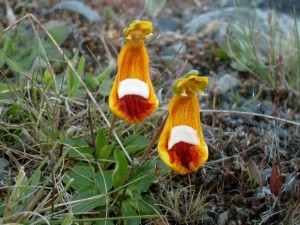
Photo courtesy of Miguel Viera (cc)
Some call it Darwin’s Slipper, other the Happy Alien, and still more call them Chamber Maids. But no matter what name they go by, these crazy little mountain flowers are truly one of a kind. Originally discovered by Darwin between 1831 and 1836, the Chamber Maids love cold weather and can still be found in profusion in Tierra del Fuego, South America. The little white “plate” section of the flower tantalises local birds who eat it and, in doing so, gather pollen on their heads and in turn aid in the pollination of the plant. If you’re on the lookout for this plant be sure to look low; the only grow to be about 4 inches tall with blooms of just 2 inches long.
#16. Passion Flower (Passiflora incarnata)
The Passion Flower has more than 400 different varieties and is known as the Clock Flower in India and Japan. When it was first encountered by Spanish missionaries, it was given its name because of its likeness to elements in the story of Jesus’s crucifixion which is also called “The Passion.” The Passion Flower produces an incredible scent that’s used commercially as well as a tasty fruit, which is used in flavourings for a number of different culinary dishes. Did you know that the Passion Flower is a food source for caterpillars and butterflies and is regularly grown on butterfly farms? Neat!
#17. Angel Orchid (Zygopetalum rhein)
Named for its uncanny resemblance to an angel wearing a gown, the Angel Orchid is one of the gems of the orchid world. It was first discovered in 1932 and is native to the grasslands of India. The Angel Orchid is a rather short orchid in stature, topping out at just 5 inches high, with a single heart-shaped leaf that sits flat on the ground. The flowers themselves bloom in clusters ranging from one single orchid flower to five. If “April showers bring May flowers,” it’s the June monsoons we’ve got to thank for the early blooming of Angel Orchids. They are the first kind of orchids to bloom with the onset of monsoon season.
#18. Dove Orchid Or Holy Ghost Orchid (Peristeria elata)
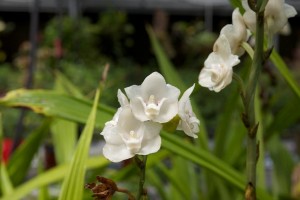
Photo courtesy of Malcom Manners (cc)
Native to and the national flower of Panama, the Dove or Holy Ghost Orchid produces delicately marbled white flowers that, if you look closely, look like they have a small dove with open wings perched inside. While most orchids can be found growing on or near trees, this type of orchid differentiates itself by growing on ground level, sometimes on rocks. The dove inside the flower is so intricate it looks almost like it’s been carved out of ivory. It is nicknamed the Holy Ghost Orchid because, in the Bible, the Holy Ghost took the form of a dove. This type of orchid is so highly-sought and over-picked that it is classified as endangered in its native country.
#19. Corpse Lily (Amorphophallus titanum)
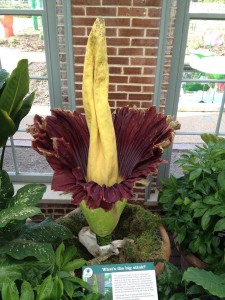
Photo courtesy of Chris Freeland (cc)
This monster of a plant was made famous in the movie Dennis the Menace. It blooms so infrequently that whenever one does, it often makes local and sometimes global headlines. The Corpse Lily is technically a compound flower and only grows in Indonesia, specifically Sumatra. Its name comes from the Ancient Greek “amorphous” which means “without form, misshapen.” Not only is this flower extremely rare, it’s extremely large, some can grow up to 12 feet tall and weigh nearly 200 pounds! If you’re still curious as to where it got its name, just take a whiff of one. The flower gives off the putrid odour of a rotting body in order to attract insects for pollination.
#20. White Egret Orchid (Pecteilis radiata)

Photo courtesy of Hiroaki Maeda (cc)
Possibly one of the most delicate, intricate of the orchids, the White Egret Orchid looks almost exactly like a White Egret in full flight. The White Egret Orchid is the most distinctive of the orchids and is extremely familiar with plant collectors and gardeners alike. A wild orchid variety, the White Egret Orchid flourishes in Asia and has also proven to successfully flourish in the United States as well. The flying bird-like flowers grow along a single spike, and a single spike can yield up to ten individual flowers and has the ability to grow up to sixteen inches tall! Quite the statement piece for any garden if you ask us
#21. Virgin Mary in Moon Orchid (Phalaenopsis amabilis)
This coastal-loving orchid comes almost exclusively in white and glitters as if covered in frost when the sunlight hits it. At first, it appears to be a typical Moth Orchid, but upon closer inspection it looks like a teeny carving of the Catholic Madonna has been placed inside. Something you may not know about the Phalaenopsis Orchid is that there is an actual Island named after them because they were once abundant there (not so much today) The island is called “Orchid Island” and is located in Eastern Taiwan.
#22. Fly Orchid (Ophrys insectifera)

Photo courtesy of Robert Shell (cc)
We warned you that there would be quite a few orchids on this list of the world’s weirdest flowers, and here’s one more. The Fly Orchid is a relatively widespread type of European orchid that grows to be between 11 and 15 inches tall with —you guessed it!— flowers that look like little flies, with big, black, bug eyes and all. But that’s not where this orchid gets its name from. The Fly Orchid is named such because it was discovered that it attracts flies and aphids. In fact, its tuber can be dried and turned into Salep, which is said to be very nutritious. However, we take no responsibility for any ill effects caused by eating your Orchids! How does it attract flies and insects so well you ask? By secreting pheromones!
#23. Protea Pinwheel (Leucospermum catherinae)
This fun flower looks more like a carnival toy than a creation of nature. Also known as the Catherine-wheel Pincushion, this is the most exquisite of the “firework pincushion” flowers. Not many flowers can compare to a bed of blooming Protea Pinwheels. The coolest fact about this flower is that it’s interconnected with fire. In the wild, Protea Pinwheels are perfectly suited to adapt to harsh climates. The best time for Protea Pinwheels to bloom is after a fire, when the adult plants, rodents, and other insects that would impede their growth have been destroyed. Protea Pinwheels ensure their continued existence by producing little fruit that is collected and eaten by ants. The ants do not eat the seeds, which remain dormant underground until there is a fire at which time the seeds are cued to begin germination.
#24. Voodoo Lily (Dracunculus vulgaris)
Native to Europe and the Balkans, the Voodoo Lily is indeed an evil looking plant. The part that gets the most attention is its dark purple “flower”. This “flower” is not an actual flower, but a spathe, like on the Calla Lily. The purple flower only lasts about three to four days and reveals a dark seed cob after it withers and falls off. Despite its tropical appearance, the Voodoo Lily is quite hard and can survive in most climates. The most interesting fact about this foreboding plant? It can give off quite a stink, and some have even likened it to the smell of a dead possum.
#25. Lithops Weberi (Lithops comptonii)
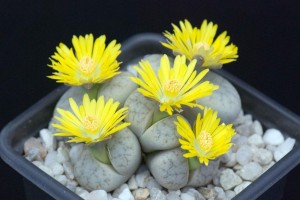
Photo courtesy of Harry Harms (cc)
You may have heard of a pet stone before, but a flowering stone? Nope, your eyes aren’t playing tricks on you, it’s Lithops Weberi, otherwise known as Living Stones. These awesome little succulents are perfect to grow indoors, especially for folks whose thumbs are not so green. These little wonders are native only to South Africa, where their evolutionary progress turned them into a drought-proof plant. When Lithops bloom, it looks extraordinary, with a white or yellow daisy poking out from what appears to be solid stone. Talk about easy to propagate! If you want to multiply your Living Stones, simply take a leaf off of one, stick it into the pebble bed and it will take root. That’s it.
#26. Brazilian Dutchman’s Pipe (Aristolochia gigantea)
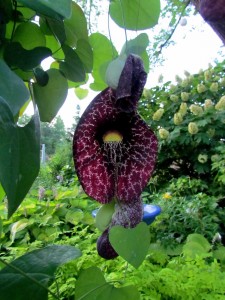
Photo courtesy of Bobistraveling (cc)
This Brazilian native vaguely resembles the Sherlock-style pipe that was popular in Holland, despite being located halfway around the globe. Also known as the Giant Pelican Plant, the flower gives off a foul odour despite its spectacular appearance. But that’s not the only thing that makes the Giant Dutchman’s Pipe less than appealing. The plant is classified as a danger to the Pipevine Swallowtail butterfly, which confuses the Dutchman’s Pipe with its native host plant. The Dutchman’s Pipe, though similar to the host plant in appearance, does not support the Pipevine Swallowtail butterflies’ eggs and will only kill the caterpillars.
#27. Star Flower (Stapelia grandiflora)
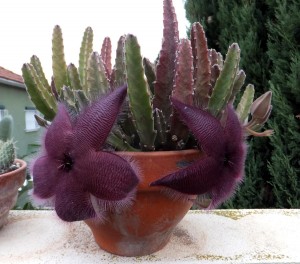
Photo courtesy of Ezequiel Coelho (cc)
Perhaps more appropriately called the starfish flower, the Star Flower is another carrion plant (a plant that mimics the smell of dead flesh). Sought by plant collectors and gardeners because of its unique, striking appearance and large fuzzy flowers, this is a plant that is best kept outside. The colour of this plant’s flowers can range from deep reds and purples to lighter pinks, mauves, and yellow. It’s touchable, hairy, leathery flower may draw you in but it’s disgusting scent will send you running for the hills. Why? Because the Star Flower’s pollinator of choice is the fly, and what better to lure flies than the sweet, sweet smell of rotting meat!
#28. Hammer Orchid (Drakaea glyptodon)
Next up comes a rather unique orchid native to Western Australia, the Hammer Orchid, also nicknames the King-in-His-Carriage. This teeny little flower is easy to miss, but if you’re lucky enough to find it, you’ll likely never forget it. The design of the Hammer Orchid (named for its ability to reset itself) is intended on luring wasps for pollination. In fact, the flower secretes a pheromone that mimics that of the female wasp, which lures unsuspecting males to land on its dark purple labellum. Once the wasp lands, the labellum moves back towards the pocket of pollen, shoving the wasp into the pollen and successfully propagating its species.
#29. Tropical pitcher plant (Nepenthes)
Tropical pitcher plants, also called Monkey Cups by those familiar with the species, can be found in many places throughout the world from Madagascar to Australia, but they’re most common in the jungles of Indonesia. These fanciful flowers look like you can walk up and take a drink right from them, but that’s the last thing you’ll want to do. In fact, the Tropical Pitcher Plants are carnivorous climbers, luring in unsuspecting insects with sweet nectar that are then trapped in the goblet-like cup and unable to escape. Tropical Pitcher Plants have been surprising people since the 1800s, but not many realise that the Pitcher Plant isn’t a flower at all—the pitchers are modified leaves!
#30. Flame lily (Gloriosa superba)
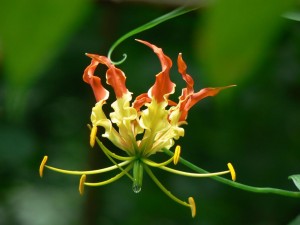
Photo courtesy of Dinesh Valke (cc)
One of nature’s true exquisite beauties is the Flame Lily or Glory Lily as it is known in Hindi. This perennial plant is both a climber and scrambler and adds intrigue wherever it grows. The Flame Lily thrives in many parts of the world and is widely propagated as a prized ornamental addition to flower gardens. Like nearly all lilies, the Flame Lily is considered poisonous to humans and animals (especially cats!), so if you insist on growing it make sure to take proper precautions. A fun fact about the Flame Lily is that it’s actually considered a weed that thrives naturally in sandy coastal conditions. That’s one weed we wouldn’t mind having in our backyard.
#31. Birds of Paradise (Strelitzia)
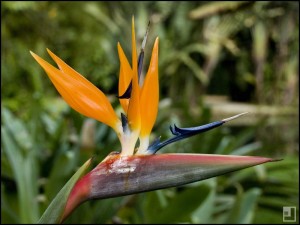
Photo courtesy of Luciano Joaquim (cc)
The Birds of Paradise flower is one of the most popular and widely-recognized tropical flower in the world. It’s aptly named for its resemblance to a Bird of Paradise taking flight. The Bird of Paradise can be cultivated outdoors in tropical, warm climates, as well as indoors for those residing in colder temperatures. Despite its intricate beauty, the Bird of Paradise flower is actually quite easy to grow and care for, requiring little maintenance other than light, warmth, and water when needed. No tropical bouquet of flowers can be considered complete without this highly-recognized tropical staple. Here’s a fun fact about the Bird of Paradise you may not know: it’s actually related to the banana!
#32. Beehive Ginger (Zingiber spectabile)
When we said, we’d be showing you 40 of the world’s weirdest flowers we weren’t at all kidding. The Beehive Ginger could very well be considered one of the top 5 weirdest flowers in the world. Beehive Gingers may look like they belong to the pine cone family but they are actually related to the ginger plant. Their little “cups” or “honeycombs” (actually called bracts) will collect water and give off the fragrance of ginger. These flowers can be cultivated indoors but require lots of room and a large pot— some growing to the height of 6 feet. The flowers are tiny and white, sometimes resembling little honeybees, and they appear between the brachts. The bracts themselves turn from lovely yellow and golden colours to red. Beehive Ginger as a cut flower is highly prized because the bracts and flowers last for a very long time after being cut.
#33. Snake Gourd Flower (Trichosanthes cucumerina)
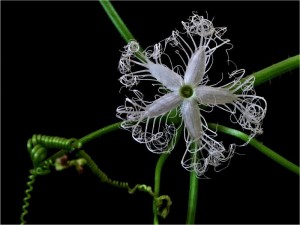
Photo courtesy of Ashim Chaudhuri (cc)
The beautiful Snake Gourd flower may look like it belongs on a festively wrapped present, but it’s actually a vegetable! The Snake Gourd originated as a wild vegetable that grew in India, but these days it is cultivated around the world. It’s a member of the pumpkin family (like all gourds) and shares similarities with the bitter melon plant, as the long vegetables, it produces taste quite sour and bitter. Despite its terrible taste, the fruit from the Snake Gourd flower is used in a variety of different medical applications, and the reddish fruit inside an overly-ripe gourd can also be used as a tomato substitute when cooking. It may be named the Snake Gourd, but we think it looks more like a spider.
#34. Spider Chrysanthemum (Chrysanthemum morifolium)
Despite its strange appearance—or perhaps because of— the Spider Chrysanthemum is a favourite flower of florists and gardeners alike. Like all other mums, the Spider Chrysanthemum is well-suited for patio or container gardening. To keep your Spider Mums blooming for as long as you can, be sure to remove faded blooms and tightly closed buds (instead of the larger flowers) to encourage new flowering. Another trick to having the biggest, best blooms is to keep them out of direct sunlight while they are flowering. This will not only extend total bloom time, but it will also help the flowers last longer in general.
#35. Pleurothallis truncata
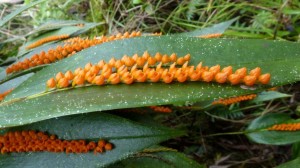
Photo courtesy of Andreas Kay (cc)
This funky flower made our list because it’s so weird it doesn’t even have a nickname! The flowers look like horizontal, orange Lily of the Valley, but they are actually a member of the orchid family. They are part of the Pleurothallis genus to be exact, also called Bonnet Orchids for their tiny blooms’ resemblance to little baby bonnets. They can grow in a variety of different ways, as brush cover, as climbers, clumped and trailing, or as tall cane-like plants. Unlike regular orchids, these orchids prefer cooler temperatures and low moisture; they grow most comfortably at very high altitudes.
#36. Devils Hand (Chiranthodendron pentadactylon)
If idle hands are the devil’s workshop, we’re not really sure what the Devil’s Hands are, but we sure love to look at them! Some call this tree the Monkey’s Hand or Monkey Paw, but we wouldn’t recommend making any wishes on it. The Devil’s Hand is native to Mexico where the Ancient Aztecs held it in extraordinarily high religious regard, who harvested the claw-like flowers for generations and generations. The fruit produced by this tree has an earthy taste and has been used for years in traditional medicine to treat heart disease and heart conditions. Unlike some tropical plants the Devil’s Hand tree is extremely hardy and can grow relatively fast, reaching upwards of 40’ to 90’ tall!
#37. Welwitschia (Welwitschia mirabilis)
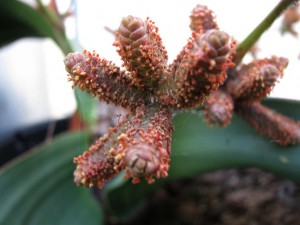
Photo courtesy of David Eickhoff (cc)
At first glance, it looks like this little plant’s got a fungus on its flowers, but that’s actually the way it is supposed to look. Another real one-of-a-kind flower on our list, the Welwitschia Mirabilis is the only member of the Welwitschiaceae family. It could be considered the Methuselah of plants; it’s been around since the Jurassic Era and in some instances can live to a ripe old age of 1,500 years. If you’ve never seen or heard of this plant before don’t be offended, it only grows in one place on Earth: a small strip of land in the Namibia Desert between Angola and Namibia. How can a succulent plant that hasn’t changed for thousands of years continue to survive in one of the driest places in the world? It gets all of its moisture from fog and dew, that’s how.
#38. Lobster Claw (Heliconia rostrata)
Our list of weird flowers would simply not be complete without the charming, colourful Lobster Claw! Also known as the False Bird of Paradise and Wild Plantain, the Lobster Claw’s cheerful flowers emerge from clumps of leaves that look like bananas. The reddish flower-like bracts actually hide the plant’s true flowers, which require birds with specialised beaks for pollination. An excellent landscape plant, the Lobster Claw can grow up to a height of 3.5’ tall and they bloom several times each year. Be sure to provide your Lobster Claws with plenty of water and fertiliser to maximise your blooms.
#39. Desert Pea (Swainsona formosa)
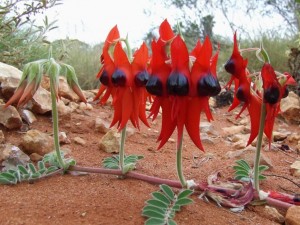
Photo courtesy of Bill & Mark Bell (cc)
This weird, wonderful flower is quite the evolutionary produce, surviving and thriving in dry, arid climates. The blood-red petals with their bulbous, purplish-black middles make these flowers look more like aliens. Perhaps that’s why the Desert Pea is one of Australia’s best-known and most recognised wildflowers. Besides, it is also the state flower of South Australia. But just because it happens to be one of the most famous wildflowers in Australia doesn’t mean you can go around and start picking it; quite the opposite in fact. The Desert Pea is among the native Australian flowers and is a protected species. As a result, it is illegal to collect or pick any without explicit written consent of the Australian government.
#40. Silver Vase (Aechmea fasciata)
Last and certainly not least on our list of the world’s 40 weirdest flowers comes the Silver Vase, or Urn Plant. This prestigious plant is native to Brazil and has garnered the Royal Horticultural Society’s Award of Garden Merit for its quality and growability. Even those with without green thumbs should be able to grow the Silver Vase plant. The Silver Vase is a slow grower with broad, waxy leaves and sharp, spiky flower heads. Once the pink flower has finished blooming, the silvery striped leaves will begin to die. However, after the flowering period is over there will be offshoots, called pups, produced towards the base of the plant that you can transplant and propagate.
I know we said 40 but there are so much more out there….. so here are ten more just for fun.
Crêpe ginger (Cheilocostus speciosus)

Photo courtesy of Forest and Kim Starr (cc)
Panda Face (Asarum maximum)

Photo courtesy of Rictor Norton & David Allen (cc)
Ceropegia denticulata

Photo courtesy of Martin Heigan (cc)
Puya (Puya berteroniana)
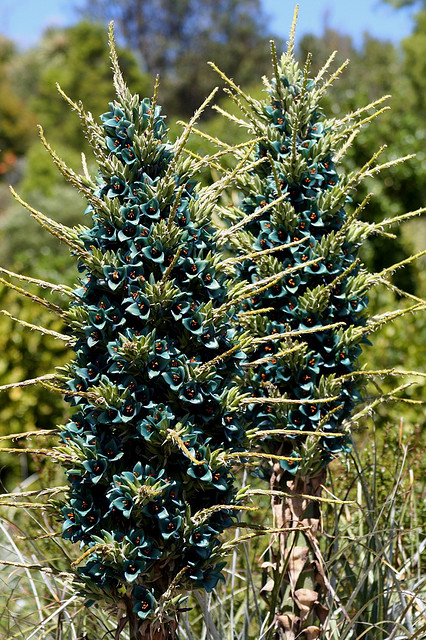
Photo courtesy of Dr. David Midgley (cc)
Bulbophyllum medusae
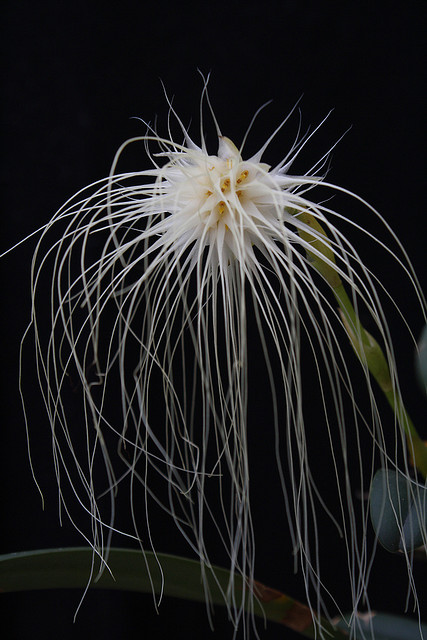
Photo courtesy of abiom.orchid1 (cc)

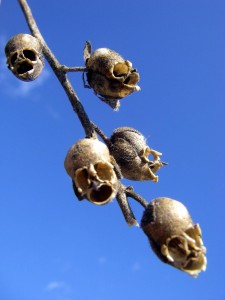
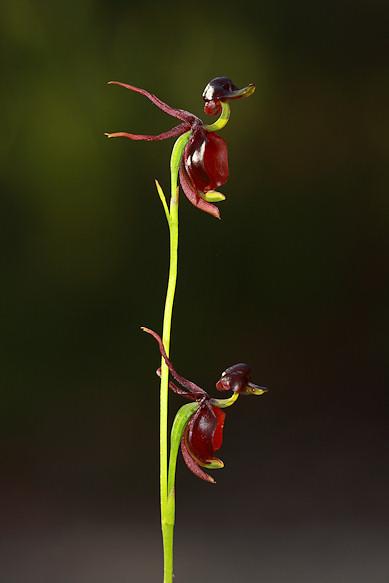

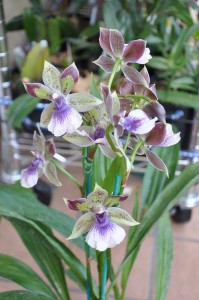
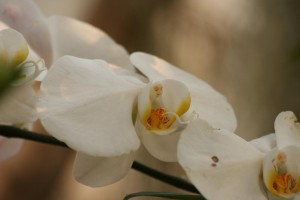
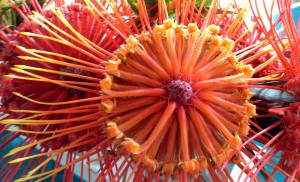
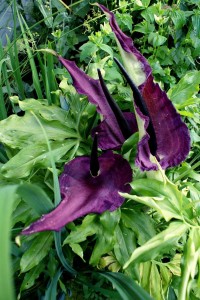
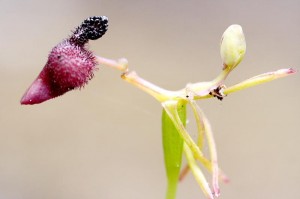
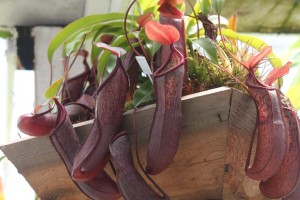
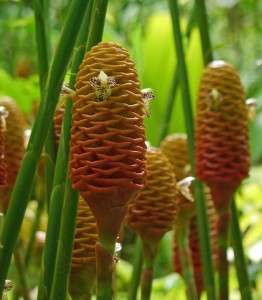
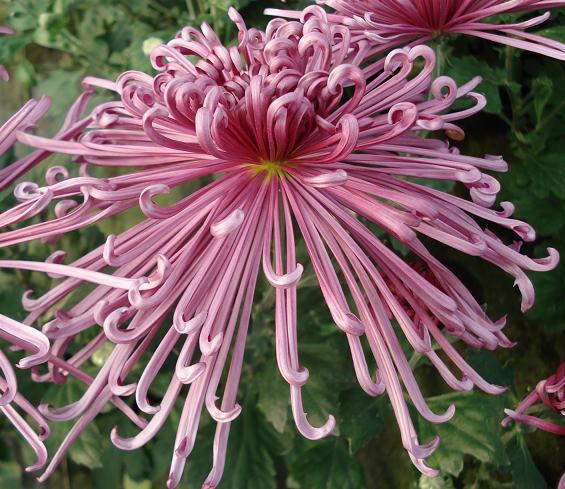
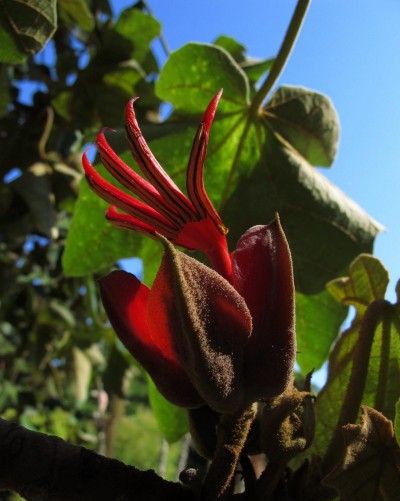
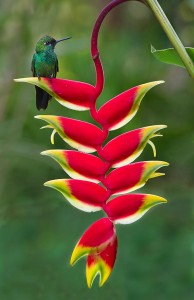
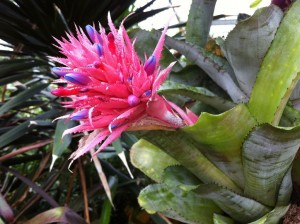


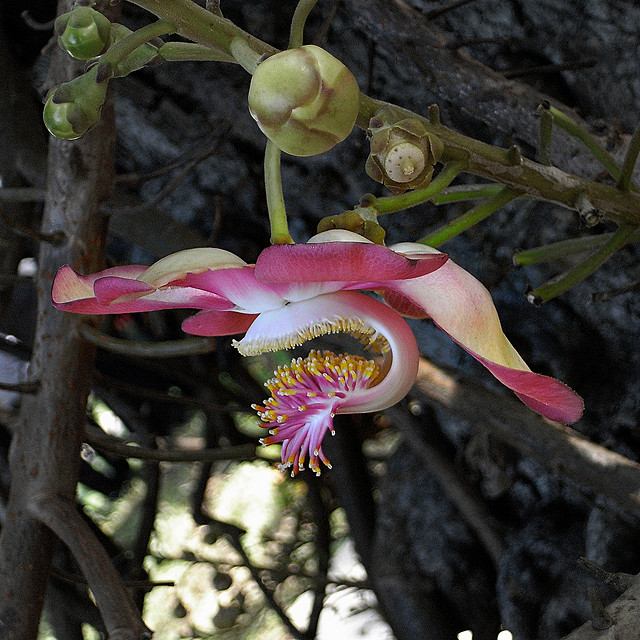
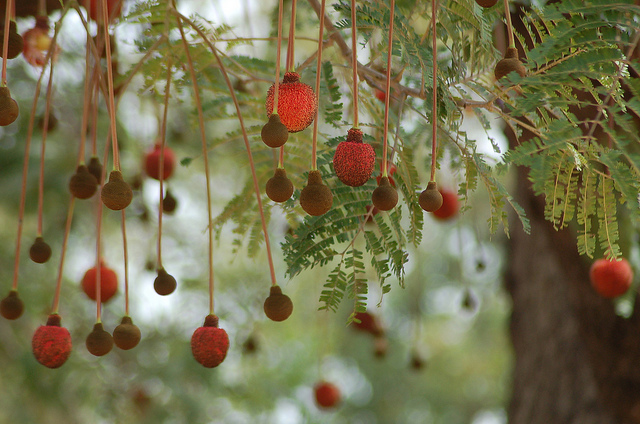

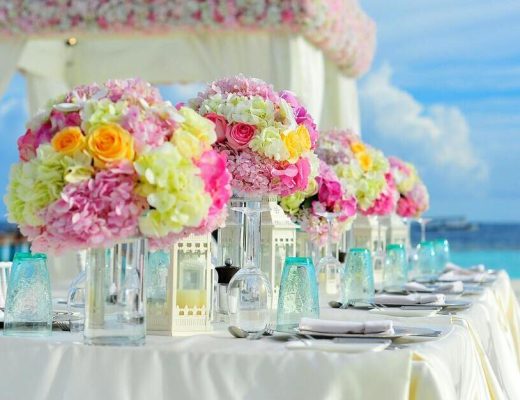

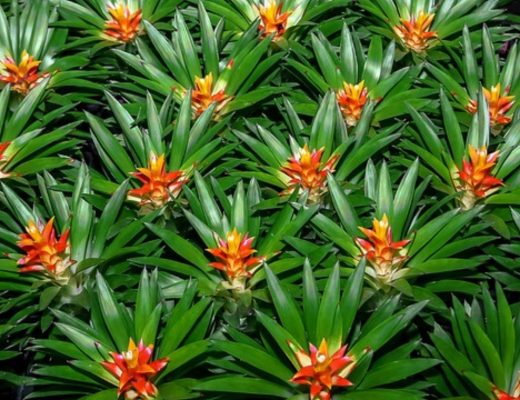
116 Comments
Bill Bell
February 20, 2015 at 1:24 amNice Work Nadina and Justin,Crotalaria cunninghamii Bird flower is another interesting native worth a mention.
#12. Snap Dragon Seed Pods look like little humanoid skulls
Have a great week end guys
Justin Hughes
February 20, 2015 at 3:58 amThanks Bill,
I had to look up Crotalaria cunninghamii and you’re right the Bird flower is an interesting one indeed!!
Thank you for sharing it with us 🙂
Alma
May 5, 2019 at 1:01 amThank you for putting all these wonderful flowers on I was looking for a flower to put in my garden, but I don’t think any of these would work please tell me what type of flower I could have it is very rainy here not very sunny and I would like a funny looking plant.
Please answer on email Alma
Melba wilSon
July 9, 2016 at 9:01 pmHi I have had a wonderful afternoon looking n reading about these extraordinary flowers beautiful. I have only 2 of them. Some are just strange looking but interesting n the names mostly go with them. 🙂
I live in Bermuda. Thanks again.
Justin Hughes
July 12, 2016 at 4:15 amHello Melba,
Thanks for your great comment 🙂 I was just curious, which of the two flowers do you have?
Patricia
September 11, 2016 at 7:37 pmI came across the Hot Lips in Pink this Summer
MAITRI
August 29, 2016 at 6:55 amHELLO SUCH A INTERESTING FACTS,FLOWERS INDEED REALLY VERY BEAUTIFUL BEAUTIFUL,WISH COULD SEE THEM REALLY
vaidehi
August 29, 2016 at 6:58 amReally i agree wholeheartedly these beautiful flowers create such a miasma of serene beauty on this planet.
Riko
February 21, 2021 at 10:42 pmYou realise miasma means: an oppressive or unpleasant atmosphere which surrounds or emanates from something
Alma
May 5, 2019 at 12:55 amI agree the #12.Snap Dragon Seed Pods look like humanoid skulls.
Alma
May 5, 2019 at 12:56 amI agree the Snap Dragon Seed Pods look like humanoid skulls.
Holiday
December 18, 2020 at 6:01 pmI was actually thinking of the same thing on how the snap dragon seed pod looks like skulls 😂 but it’s also kinda creepy and cool at the same time 😁
sara green
February 23, 2015 at 2:10 pmvery interesting plants so many oddball Plants with such beauty.
Ynn holder
February 23, 2015 at 3:14 pmI would like to know where I can get some of these plants in the Phoenix area especially the star flower I just love these plants
DEbbie
January 6, 2016 at 6:53 pmDid you find out where to get some of these amazing plants?
Hedy
May 9, 2016 at 3:11 pmEldon Tropicals has a number of these.
Justin Hughes
May 11, 2016 at 7:37 amThanks for letting us know Hedy 🙂
janis petercsak
February 23, 2015 at 10:10 pmI have had this plant for seven yrs. it was in bloom {one bloom only} I work in the seasonal dept and it was the only time we had ever sold that plant. there were only a half dozen of them. I bought mine home, watered it every ten days or so. I never thought to fert. it figuring it was in the aloe family. this summer I figured MAYBE if I gave it cactus food, it just MIGHT bloom. I fed it and forgot about it it was on a window sill behind the curtain. about six wks later I took a look….there was a purple bud hanging. was very concerned such a big bud on such a little branch. after around 3 wks it bloomed! So lovely….now thanks to you I know what this unlabeled plant was……a star flower! by the way, there was no scent at all emitting from the bloom.
Justin Hughes
February 28, 2015 at 1:31 amHi Janis,
I am so glad that we could help you identify the mystery pot plant. There are quite a few different Stapelia species around and you may have gotten lucky by finding one that does not give off a foul scent 🙂
In my experience the Stapelia are happiest on a window sill with lots of light, not too much water, free draining and fertile soil. Also you should be able to take cuttings from them in spring to produce more plants.
Harry Harms
March 11, 2015 at 3:48 pmNice collection of indeed weird creations of nature. # 25 is a photo of one of my flowering lithops plants
Justin Hughes
March 15, 2015 at 7:19 amThanks Harry, and Thanks again for letting us use one of your Lithops Photos!
enedina fioreze
March 13, 2015 at 11:47 pmMuito interessante, amei essas belas flores que nascem diferentes locaia. lindas
(Very interesting, loved these beautiful flowers that are born different Locaia . beautiful)
Justin Hughes
April 10, 2016 at 12:44 amThank’s for the positive comment Enedina.
fred
March 23, 2015 at 4:09 pmwow nice collection very nice i loved the Devil Hand
Justin Hughes
April 10, 2016 at 12:39 amThank’s Fred, the Devils hand is one of my favourites!
EMily
March 25, 2015 at 3:09 pmVery cool collection
Justin Hughes
April 10, 2016 at 12:44 amThank you Emily.
Tatiana (Tatters)
March 29, 2015 at 10:53 pmWow, Justin, – well done! Love that collection of “weird” flowers (though too many Orchids among them).
I found many familiar plants and familiar flickr photos there.
regards
Tatiana
Justin Hughes
March 31, 2015 at 8:30 amThanks for the kind words Tatiana, sorry for adding too many orchids 🙂 and thanks again for letting us use your photo (The Elephant Apple (Dillenia indica)).
Yvon
June 19, 2015 at 3:50 pmI have heard of the monkey face flower before, is it exclusively in Australia or can they be bought in other places of the world too? In contrast, I would not like to have a corpse flower. I was thinking it looked more like a mushroom than a real flower, so is it a fungi or is that up for debate?
Justin Hughes
June 24, 2015 at 4:55 amHi Yvon,
Unfortunately to our knowledge the Monkey face orchid will not grow in Australia. It is native to parts of South America growing at altitudes between 1000 and 2000 meters. It’s extremely hard and rare to grow one in captivity due to the complex conditions which it requires to grow.
Beware of monkey face orchid seeds being sold online as there is very little chance you will be able to germinate them.
Simply the common name of the Rafflesia “Corpse flower” was enough to put us off wanting one too :). The Rafflesia is not a fungi, in 2007 a definitive study in the journal Science discovered it belongs to a large flowering plant group known as the Euphorbiaceae which is the same family of the poinsettia and the rubber tree.
Ann
August 6, 2015 at 12:05 pmThank you for such a unique and special site. I am a self employed gardener, and a neighbour called me in yesterday to show me a rare plant she has and asked me to find out about it! Thanks to this site I was able to ID her plant. (Can’t wait to show her!!)
It is the Panda Face (Asarum maximum) and it is in flower.
So thank you very much.
Kind regards,
Ann.
Justin Hughes
August 6, 2015 at 8:11 pmHi Ann,
You’re welcome, so happy that we could help 🙂 It would have been a nice surprise to see the flowers peaking out from under the foliage. Its a nice plant, one we would love to have in our gardens. Just out of Curiosity was it growing indoors or out in the garden?
Cheers
Ida mae Thomas
August 7, 2015 at 12:58 ami would like to know how to get three Flowers please.
Justin Hughes
August 7, 2015 at 5:33 amYou would need to check with you local garden centre to see if any are available. Beware of buying seeds off the internet from unknown sources, they may not germinate or even be the correct seeds.
Ida mae Thomas
August 9, 2015 at 4:20 pmthank you do you have any seeds
Justin Hughes
April 10, 2016 at 12:52 amSorry for the late response, I missed this reply. Unfortunately, we do not sell the seeds as we would not be able to guarantee the germination of them. Did you have any luck with your local garden centre?
Billy
August 12, 2015 at 6:04 pmWhere can one get the naked man orcid or any of these beautiful flowers?
Justin Hughes
August 12, 2015 at 8:18 pmHey Billy,
Best place to try for Orchids would be your area’s “Orchid Society” (Google search), contact them and I am sure they could point you in the right direction and great advise.
The Naked man orchid and a few of the other plants in our list may only grow in certain special conditions and some of the plants need a special fungus to be living in the soil for the seeds or plants to grow.
Check with your local garden centre to see if they can source some of these plants for you.
let us know how you go.
LUlu
August 26, 2015 at 7:01 pmLove the lobster claw flowers. Though they really remind me of the opening credits to the Partridge Show. Awesome job on the article.
Justin Hughes
August 27, 2015 at 11:28 amThank you, Lulu 🙂
Sheila
October 7, 2015 at 2:23 amWhat a testimony to the mind of the Creator, God.
Praises…..
cecelia burke
October 8, 2015 at 12:17 amJust wanting to know where I can purchase seeds for those flowers on your site. Please reply soon, I Live in Canada. We do grow some flowers indoors and outdoors as well. Thanks
Justin Hughes
October 8, 2015 at 8:28 pmHello Cecelia,
Unfortunately, we cannot help you with seeds for these plants. Most of the plants that we featured require special conditions to grow in. Orchids might be a good option for indoors, you could try contacting or joining an Orchid Society/Club in your area to get more information on which Orchids are available:
http://www.ecosorchids.ca/
http://www.canadianorchidcongress.ca/
Amber smith
November 10, 2015 at 9:54 pmthere so beautiful sike no there not
Justin Hughes
April 10, 2016 at 12:48 amHa! beauty is in the eye of the beholder!
Mitesh
December 16, 2015 at 6:20 amHi, from where could I purchase the plants/seeds?
Justin Hughes
January 8, 2016 at 2:33 amHi Mitesh,
Which State or Country do you live in?
Cheers
FAM Team
Diana
December 20, 2015 at 6:12 pmAloha, I live on Hawaii Island and at local gardener’s exchange encountered a unique orchid type plant with two large fleshy white flowers (one had already emerged and is now browning from same stem that the second one bloomed that is still in bloom. There is a yellow tag indicating it has been “bred” but I am not familiar with the abbreviations. The foliage is deep matte green and leaves are about 12 inches long arranged in opposition, resembling a vanda type, the white fleshy bloom spectacular 5 inches from tip to tip. The words on the tag are “Angem. Lemford whitey Beauty” allowing for possible mistaken interpretation. I am familiar with most orchid types here but aware there are collectors and of course those who are actively hybridizing. Mostly curious if any way to determine which continent or country the “relatives” may come from?
Mahalo.
Diana
December 20, 2015 at 6:21 pmAloha again, I just answered my own question at another weblink. This plant is a relative of Star of Bethlehem orchid Angraecum sesquipedale (originating in Madagascar) . I will try to copy the weblink to Paramount Orchids site if this blog will permit?
http://www.paramountorchids.com/jpg/Angraecum%20sesquipedale21.jpg
Mahalo for your patience.
Justin Hughes
December 21, 2015 at 12:41 amAloha Diana,
Nice detective work!
I would like to add a little more information on your orchid. The genus is Angraecum which contains around 200 species. If the tag is correct then the Orchid you have is a hybrid, produced from the king of Angraecums “Angraecum sesquipedale” and the Queen, “Angraecum magdalenae”.
The Lemforde White Beauty is a fantastic Orchid to have and is very sought after!
Check out this great blog post for some more information: http://angraecums.blogspot.com.au/2012/02/offspring-from-king-queen.html
Mele Kalikimaka me ka Hauʻoli Makahiki Hou,
Flowers Across Melbourne Team
tRaci
January 5, 2016 at 11:24 pmI live in Dallas, Texas and actually picked up one of these curious plants at my local grocery store (Kroger). I have been searching and searching the web for what this potted jewel could be. I’m not tech savvy so this was definitely a task! This was the first place I found the flower and wanted to thank you for your work. Who knows if and when I would’ve found out considering I was about to give up (at least for today). The only label on the plant was the price sticker which said “fresh from European floral garden $27.99”. Looks identical to the picture. This was fun to see all the other cool ones as well! Thanks for taking the time. 😊
tRaci
January 6, 2016 at 12:11 amOops! Ha ha ha… Totally forgot to say that it was the Silver Vase. Just barley made the list! Couldn’t be happier for the number 40. 😜
Justin Hughes
January 8, 2016 at 2:11 amHey tRaci,
Thanks for the kind comment and I am glad that we could help you identify the Silver Vase. Let us know if produces an awesome flower!
All the best,
Justin and Flowers Across Melbourne Team
Patricia Walters
March 22, 2016 at 3:36 pmWhere can I buy a Hanging naked man plant?
Kim Underwood
April 4, 2016 at 2:05 amI love a lot of your orchids and a lot of the weirdest plants too. I’m interested in knowing where can I get some.
Justin Hughes
April 9, 2016 at 11:34 pmHello Kim,
A few of the plants can only be grown in certain, special conditions and could be hard to source them. A good option would be to have a look online and see if you can find a local Orchid Society or group. The members of the Orchid groups will be able to offer advice on which orchids can be grown in your location and what is available. As for the other weird flowering plants, be cautious buying seeds from unknown sellers, maybe try your local plant shop or Nursery. Good luck
LINDA
April 6, 2016 at 6:07 am#31: birds of Paradise. I was told once before that this flower is also nicknamed”the Evil Mother-In-Law”. Please correct me if I am wrong. I hope I am wrong.
Justin Hughes
April 10, 2016 at 12:15 amHi Linda,
That’s a terrible nickname 🙂
We have not heard of the Bird of Paradise being called the Evil Mother-In-Law. But it may be known as that in other countries?.
The Derivation of the name ‘Strelitzia’ was named in honour of Queen Charlotte, King George III’s wife but she did not have any step children. (15 of her own, though!)
A plant/flower that springs to mind is the Sansevieria trifasciata which is commonly called the Mother-in-law’s tongue
If anyone else has heard the Bird of Paradise flower called something else, then please let us know.
Yvonne
April 13, 2016 at 3:02 pmI will be searching for some of these very beautiful and unique plants. Thanks for
your 40s list
Justin Hughes
April 15, 2016 at 11:04 pmThanks Yvonne, let us know how you get on!
Brianna shum puiyan
April 20, 2016 at 12:02 pmThanks, that help me with my work!!! I like the Hooker’s Lips and Monkey Face Orchid!
Justin Hughes
April 21, 2016 at 9:12 amYou’re welcome Brianna, happy to help 🙂
Brianna SHUM PUIYAN
April 20, 2016 at 12:04 pmThanks again, this was awesome!
Seth
May 8, 2016 at 12:33 amSimia means monkey not primate.. Primates have thumbs and tales. Monkeys do not.
Justin Hughes
May 9, 2016 at 3:23 amHi Seth,
Thank you for your feedback. My Biology and Taxonomy knowledge are limited and I have to rely on the experts such as Yoshihito Niimura and the great Carolus Linnaeus, but my research often results in conflicting data.
Even though this article is about flowers, I would love to know if anyone else could shed some light on whether the Latin word “simia” means Monkey or Primate, or perhaps it means both?.
Noel Hall
June 18, 2016 at 8:30 pmSimia is latin for ape, probably also from simus, flat nosed and from the Greek, Simos.
Justin Hughes
June 20, 2016 at 1:13 amThank you Noel.
Linda
May 10, 2016 at 3:31 pmHi Justin,
Can you give me a list of any of these plants that will grow in
Australia (Melbourne), there are quite a few I like…
Regards,
Linda:)
Justin Hughes
May 11, 2016 at 8:04 amHi Linda.
Most of these flowers are rare and will not grow naturally in Melbourne. Lots of the Orchids would grow happily inside your house, check out http://www.australianorchids.com.au they are on the Mornington Peninsula or http://www.pioneerorchidfarm.com.au near Geelong.
Growing these plants is not a problem if you can control the conditions (Indoors etc), the hard part is seeing if you can get them. The best thing for you to do is drop into your local nursery (actual nursery not the big hardware chains) and ask them what’s available. There are lots of different hybrids with similar flowers that may suit our conditions, it’s just a matter of finding a nursery that can supply them. Please let us know if you find any 🙂
Linda
May 10, 2016 at 3:34 pmP.S…I have read about some of these plants on other websites, but your description and overview of them was very informative and interesting…you also included some very interesting ones I haven’t heard of before, thanks Justin,
Regards again,
Linda:)
Justin Hughes
May 11, 2016 at 8:05 amThank you Linda, much appreciated 🙂
kaleightollison
May 11, 2016 at 5:19 pmI think that they are all really cool
Justin Hughes
May 13, 2016 at 7:58 amMother Nature has some pretty cool stuff in her little bag of tricks.
kaleightollison
May 11, 2016 at 5:19 pmI think that it is really cool
william Beatty
May 16, 2016 at 3:24 amgreat plants i would like to grow them
lINA
June 13, 2016 at 9:59 amRafflesia Arnoldii and Titan Arum are 2 different flowers. Check Wikipedia.
Justin Hughes
June 13, 2016 at 10:13 amWe totally agree with you. The names alone identify them as different plants, and it would be silly to think they are the same flower.
PRETTY GIRL 101
July 13, 2016 at 12:02 am#38 the lobster claw is known to be a balisier in Trinidad and Tobago
Justin Hughes
July 14, 2016 at 2:25 amThank you very much, I would love to know what other flowers are known as in different countries.
Billy Miller
July 28, 2016 at 5:55 pmII am trying to identfy a flower my neighbor has. They are sky Blue covered with prickly spikes, Afer flower is done it leaves a spiny brown pod full of seeds, Of course I picked lots of seeds but I would like to know what the flower is.
Justin Hughes
July 31, 2016 at 11:40 pmHi Billy, Very tough one to figure out without actually seeing the plant or flower. This is a stab in the dark, but have a look at “Eryngium planum” common name “Sea Holly”.
meeemooo
August 1, 2016 at 6:48 pmi loved the first flower because i love monkeys♥♥♥
Justin Hughes
August 2, 2016 at 10:37 amLol, nice one meeemooo 😛
Gerard
August 22, 2016 at 1:08 pmThanks Justin for all these beautiful pics and the related info. I love plants and nature in general and orchids in particular. I really enjoyed browsing the site.
As an orchid enthusiast, I noticed that there is some inconsistency about entry #21 for Virgin Mary in Moon Orchid (Phalaenopsis amabilis): phalaenopsis plants do not have any bulb or pseudobulb. The description about ants that is given would probably better suit the genus Myrmecophila (also a member of the orchid family).
Justin Hughes
August 23, 2016 at 11:52 pmHi Gerard,
Thank you for the feedback, you are totally correct, the Phalaenopsis amabilis does not have a bulb at all! This is a little bit embarrassing but mistakes do happen.
I will update the content and thank’s again for picking up on that.
Cheers
Justin
Chris
September 16, 2016 at 3:38 amDoes anyone know the flower or plant that the bud looks like a praying Saint/monk?
Justin Hughes
September 19, 2016 at 11:30 pmWe would love to know too, sounds weird and interesting.
mahendra
September 16, 2016 at 8:47 amthnks
Justin Hughes
September 19, 2016 at 11:27 pmIt was our pleasure.
Lili
October 11, 2016 at 6:57 pmwoww awesome collection… i loved them all – but – especially hanging man , monkey and also lithops weberi i found those cute and sure easy to get eventually in flower shops .. i have to look out for those 🙂
i have seen the one “spider” flower but.. there are so many more of spiderflowers that looks really amazing, so many versions of them 🙂
you really made an beautiful web-page and thanks for sharing it wtih us all :))
(have already linked some friends – coz its just so amazing and lovely, that it would be not fair to NOT share) 😀
i like lilys + orchids alot so i am sure happy i stumbled over this page here lol
have a happy day you all………! *waves* 🙂
Justin Hughes
October 18, 2016 at 5:10 amThanks so much for sharing Lili, your comments have made our day 🙂 hope you have a great day too!
Jessica
October 12, 2016 at 11:05 amWohhh!!! Extraordinary flower collection, I wish could have them all… Still I have three types of indoor orchid’s plants, looks equally beautiful. You should also try!!
Sam
October 17, 2016 at 5:41 amWhat an amazingly fun read. Gave me some good ideas for the garden too -now to research which ones I can get through customs
Beautiful flowers
October 24, 2016 at 12:09 pmInteresting site and also impressing one. I read your article very nice to get them I am very impressed with your site Thank you for giving such a great information. You made the best, Thanks for sharing posts
racjonalny minimalizm
November 8, 2016 at 5:46 pmSomebody essentially help fpfoggd to make seriously posts I would state. This is the first time I frequented your web page and thus far? I amazed with the research you made to make this particular publish incredible. Great job!
Justin Hughes
November 11, 2016 at 12:34 amThank you very much. A lot of time and effort went into this post 🙂
Allan Christensen
June 13, 2018 at 10:47 amIt is really an interesting post. There are so many weird flowers in this article compared to what I research so far. A good source of information with regards to weirdest flowers in the world. The time you put in to do this kind of research was really superb. Great job and thank you for sharing this.
FAM
June 22, 2018 at 8:05 pmThankyou, we had a great time putting this one together!
Nandita Dhuri
August 3, 2018 at 6:40 pmThese are simply awesome flowers . The flowers are weirdest one’s . I enjoyed a lot reading this beautiful and colourful flowers blog .
Semon K
August 8, 2018 at 10:19 pmBeautiful post ! These flowers seem very different and weird ,But it is the fact that flowers with these names and structures are amazingly different.
Autumn
October 18, 2018 at 3:28 pmI am actually delighted to read this web site posts which consists of lots of useful
data, thanks for providing these information.
Sinta Wiranata
February 8, 2019 at 2:01 amThe 40 of the world weirdest flowers are totally rock!. Your article really make me inspire so much. I have a homework from my school and I don’t know what to do. Thank you for sharing weirdest flowers especially monkey face of orchid its really fuuny!. deroosbv.com
Heather G
April 21, 2019 at 8:34 amDon’t know if its a regional thing or not could be just the scientific community redefining botanical nomenclature AGAIN, but in north america bleeding heart Lamprocapnos spectabilis is known as Dicentra spectabilis…also was wondering if Panda face Asarum maximum has edible rhizhomes like its other ginger relatives?
Gitanjali Sinha
April 26, 2019 at 2:05 pmWawhhhhhhh. It’s so fabulous. Heaven like. Out of the world we are living in. All d flowers are beautiful & so unique indeed. Loved d lobster most.
sravanajupalli
May 21, 2019 at 5:56 pmIt was very nice.Thank you for sharing this
Errik
June 1, 2019 at 3:34 pmWow, these are weird but some of them are beautiful, amazingly beautiful.
douglas
April 28, 2020 at 11:50 pmthese are wierd!!!!!!!!!!!!!!
Sean
November 12, 2020 at 3:13 pmThey definitely are!
Dith
June 8, 2020 at 3:51 amYour collection of flowers is wonderful; thank you for the enjoyment. I ended up there looking for a flower whose name starts with the letter “U”. My daughter is doing an embroidery sampler with a flower for each letter of the alphabet, so I am helping her look for a “U” candidate. Do you know of one? We haven’t had much luck so far, but have been looking at American flowers, mostly.
Sean
November 12, 2020 at 3:08 pmHi Dith,
I’m glad you found the guide useful. I think there are plenty of flowers with scientific names that start with “U”, but I’m not sure about common names.
Good luck with your search!
Sean
amy
July 10, 2020 at 6:48 amyou should add Skeleton Flowers to the list! What’s great about them is that their petals turn transparent when it rains on them. Definitely my new favorite. I love this article!
Sean
November 12, 2020 at 2:59 pmThanks Amy, if we update this guide then skeleton flowers are definitely worthy of appearing on the list!
Glad you loved the article!
Gitanjali Sinha
April 15, 2021 at 8:27 pmPayu & the bat looks dangerous
But bat was quite pretty…………..
Its such a lovely site……..
Thanks to God for his beautiful lovely creations.
We all humans must definitely save them from being in the path of extinction……..
Kathleen Beeman
June 15, 2021 at 8:40 amThere are two that I’m sure you’re familiar with. They are so beautiful. One is Diphylleia Grayi or Skeleton Flower. And also Geum Triflorum or Prairie Smoke. The latter looks like cotton candy during the flowering phase. The Skeleton Flower is transparent when it rains. Looks like glass to me.
I really enjoyed your article. I’m always fascinated by things that are unusual.
Justin Hughes
August 10, 2021 at 6:44 pmThank you Kathleen for your kind words and we are so happy you enjoyed this. I also love the Skeleton Flower and Prairie Smoke, Thanks for mentioning those two, well worth checking out 🙂